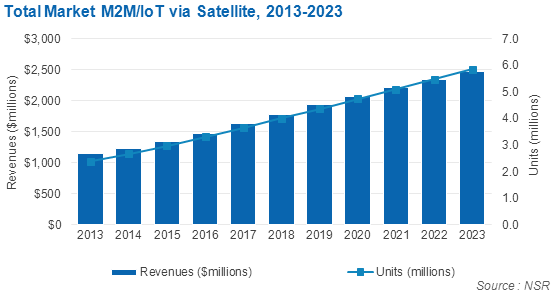The Absent Demise of M2M/IoT via Satellite
Jan 5th, 2015 by
Alan Crisp, NSR
When most businesses first dabble with
machine-to-machine (M2M) and Internet of Things (IoT)
communications, the first solution that comes to mind isn’t
satellite, but cellular-based options
from Vodafone, Verizon or Kore Telematics, to name a few. Why
then, are satellite M2M products not in decline despite having a
single-digit share of the overall M2M market, with terrestrial
services enjoying a continually growing footprint,
ever-increasing data speeds and lowering data costs? And what
will the impact be of new low-cost cellular operators such as
Sigfox?
Looking at data from NSR’s
M2M and IoT via Satellite, 5th
Edition, far from any sort of demise, it is expected that
overall satellite revenues will reach almost $2.5 billion by
2023. With 50% of these revenues expected to come from North
America where terrestrial coverage and reliability is
widespread, terrestrial competition isn’t being felt immensely.
This trend is combined with a continuing uptake in terminals on
satellite M2M networks, reaching nearly 6 million units by 2023
– an impressive growth from 2.4 million units that were in use
in 2013, resulting in a CAGR of 9.3% over the period.
In terms of key sub-verticals,
M2M and IoT via Satellite, 5th
Edition breaks the M2M/IoT market into 10
sub-verticals, including Transportation, Green Energy and Civil
Government. Of these, the two largest by a wide margin are, and
will continue to be, Transportation and Cargo. Throughout the
duration of the forecast, these two sub-verticals will account
for between 65% and 70% of the total market for in-service
units, and just under half of total revenues for much of the
forecast. This is despite the Transportation sector being the
most prone to terrestrial competition, with trucks and cars
spending the majority, if not all, of their time within a
cellular footprint.

The strengths of satellite based M2M are many, and
in most cases they are strengths that are most relevant, and
most valuable, to high-SLA type applications in remote regions,
such as offshore Oil & Gas, Transportation, and Cargo shipping.
Among other things, satellite connectivity is oftentimes more
reliable, especially in remote and underserved regions. In
developing regions, terrestrial networks are often nowhere near
as reliable as those in the North American region, or is often
non-existent in other regions. Without near 100% reliability and
availability, the value proposition derived from M2M
communications by knowing where everything is at anytime,
anywhere, begins to fall apart. Beyond that, satellite-based M2M
can offer truly global coverage, with applications such as
trans-oceanic shipping being addressable only via satellite.
Countering any perceived decline by the growth of
terrestrial M2M, satellite M2M operators are expected to focus
on these core strengths in the future, to further differentiate
themselves from the perpetually lower costs of terrestrial
networks, focusing instead on reliability and global coverage.
Additionally cellular networks are slowly moving from high,
value-based pricing, to low, cost-based pricing. Satellite
operators, rather than “racing to the
bottom” and losing out to cellular players on cost, latency and
speed, will rest assured that the satellite experience will be
near impossible to replicate terrestrially; as much as
associations such as the M2M World Alliance and Global M2M
Association are attempting to create a single, global and
seamless experience over a patchwork of independent terrestrial
networks.
Consolidation in the terrestrial M2M market shows
that operators are getting serious with competing. With Vodafone
acquiring Cobra Automotive technology for vehicle tracking and
telematics, Raco Wireless acquiring Position Logic, for B2B
location services, and back in 2012, the high profile
acquisition of Hughes Telematics by Verizon for in-car wireless
services. Along with many more acquisitions, terrestrial
operators mean business. With an increasing turn-key application
base, it’s becoming easier than ever to setup M2M services for
low cost for a wide range of verticals.
Furthermore, new up-and-coming terrestrial players
are expected to change the market dynamic, with newer operators
such as Sigfox offering low-end M2M and IoT products for as low
as $1/month. However, these products are expected to offer very
low bandwidth of 100bps on non-traditional wavelengths. Aiming
for the low-end, this could be pre-packaged into products with
multi-year prepaid deals. Due to the very low-end nature of this
new breed of providers, there is likely no threat, nor
partnership opportunities, with these low-end providers.
Nevertheless, this shows the wide base of M2M opportunities
available now and into the future.
Bottom Line:
Satellite based M2M services, far from being in
decline, will continue to offer unique advantages that other
forms of M2M communication won’t be able to match. With
constantly expanding terrestrial footprints, satellite operators
are expected to compete instead on reliability and focus on high
value applications such as the Transportation and Cargo sectors,
allowing the industry as a whole to not only survive in the face
of competition, but also continue to thrive well into the
future.